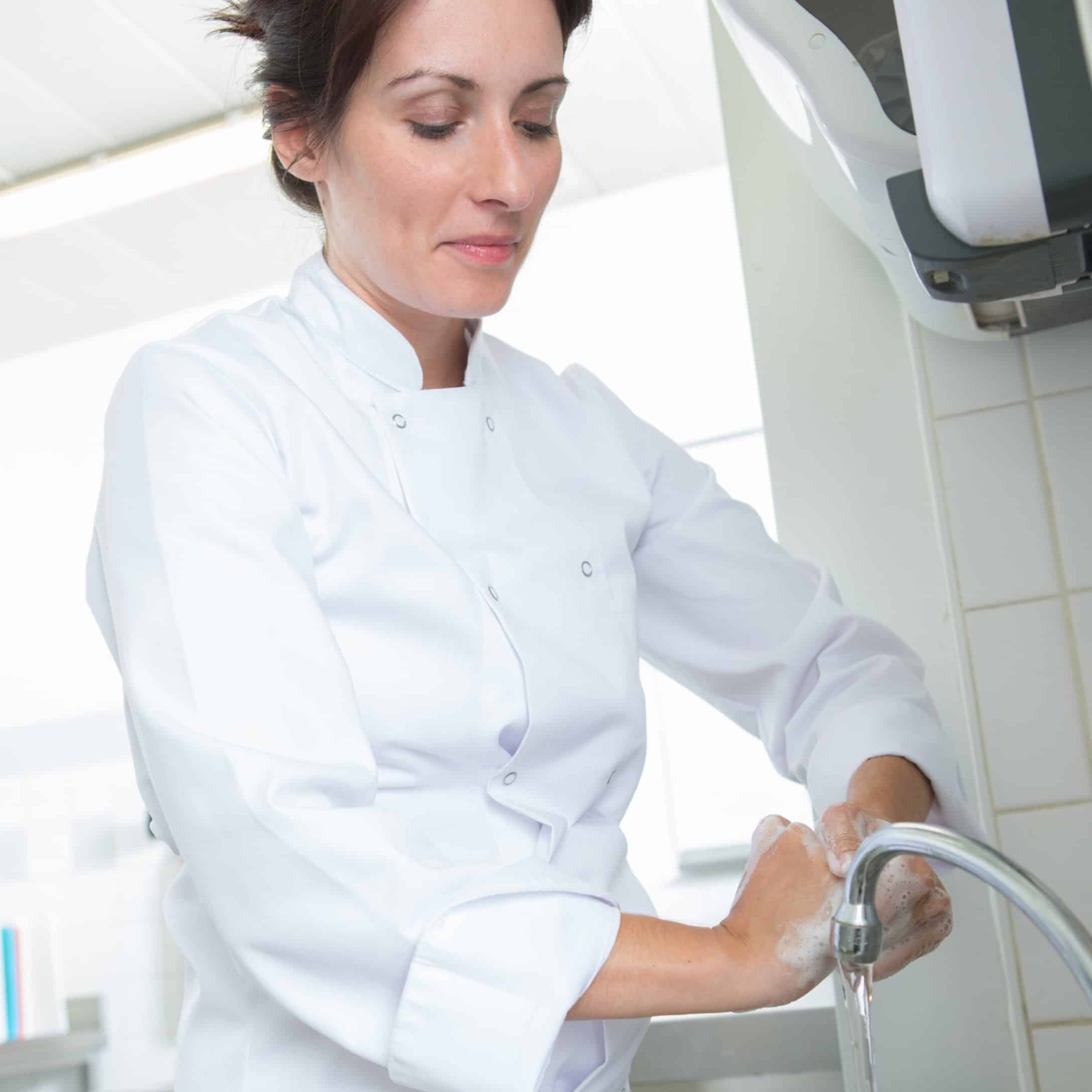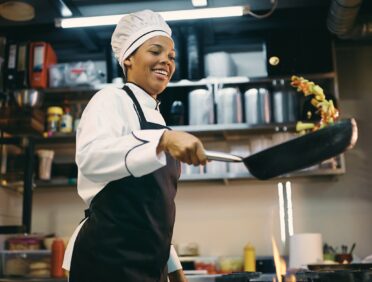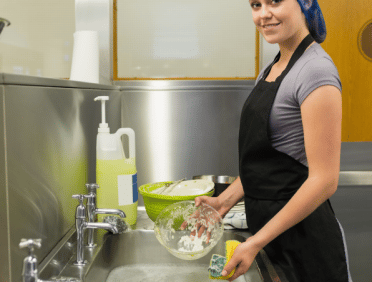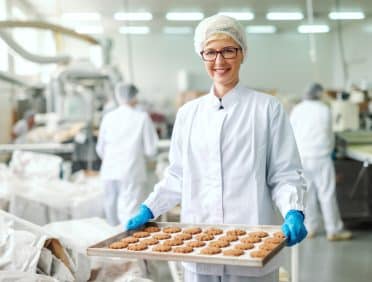What is food safety in the kitchen?
Food safety in the kitchen refers to a set of practices and procedures that are put in place to prevent food from becoming contaminated with harmful bacteria, viruses, and other microorganisms that can cause illness or disease.
It involves the use of proper hygiene, such as washing hands regularly and keeping kitchen surfaces and utensils clean and sanitised. It also involves proper handling, storage, and preparation of food to prevent the growth of harmful microorganisms.
For instance, food should be cooked to the appropriate temperature to kill any harmful bacteria that may be present, and raw meat, poultry, and seafood should be separated from other foods to prevent cross-contamination. Additionally, safe water sources should be used for drinking and cooking, and food expiration dates should be followed, with expired or spoiled food being properly disposed of.
Food hygiene Regulations UK
The Food Hygiene Regulations in the UK are a set of laws and guidelines that govern the safety and hygiene of food throughout the entire food chain. The regulations apply to all stages of the food production process, from the initial harvesting of raw materials to the preparation and sale of finished products. In terms of kitchens, the Food Safety Act 1990 is one of the most prominent regulations that sets out the basic framework for food safety and hygiene.
The Food Safety Act 1990 provides the legal basis for the Food Standards Agency (FSA), which is responsible for food safety and standards throughout the UK. It places a duty on food businesses to ensure that the food they produce or sell is safe for human consumption. The Food Safety Act 1990 requires businesses to follow appropriate hygiene practices and to implement effective food safety management systems, such as Hazard Analysis and Critical Control Point (HACCP).
The Act also empowers local authorities to enforce food safety regulations and to take legal action against businesses that fail to comply with the regulations. Local authorities can issue improvement notices, prohibition orders, and even prosecute businesses for food safety violations.
One of the key provisions of the Food Safety Act 1990 is the requirement for food businesses to provide accurate and truthful information about the food they sell. This includes information about the ingredients used, any allergens present, and the nutritional content of the food.
In addition, the Act provides for the establishment of food safety standards for specific foods, such as meat, dairy, and fish products. The Food Standards Agency (FSA) is responsible for setting these standards and ensuring that they are enforced.
Kitchen Hygiene Rules
Kitchen hygiene rules are set out in the Food Safety Act 1990 (see above) and the Food Hygiene Regulations 2006.
Have a look at some of the key kitchen hygiene rules below:
Avoid cross-contamination
Cross-contamination is the transfer of harmful bacteria or other microorganisms from one surface or food item to another. It can occur during the delivery, preparation, or storage of food, and can lead to foodborne illness. Here are some tips on how to avoid cross-contamination when dealing with delivered foods, preparing, and storing food:
- Delivery: When receiving delivered foods, inspect the packaging for any signs of damage or contamination. Also, make sure the food is delivered at the correct temperature. If you suspect the food has been contaminated during delivery, do not accept it.
- Preparation: Always wash your hands before and after handling food. Use separate cutting boards and utensils for raw and cooked foods. Clean and sanitise all surfaces and utensils that come into contact with food. Avoid using the same utensils for different food items without cleaning them in between.
- Storing: Store raw meat, poultry, and seafood separately from other foods to prevent cross-contamination. Use airtight containers or storage bags to prevent bacteria from spreading. Store food in the refrigerator or freezer at the correct temperature.
- Cooking: Cook food thoroughly to kill harmful bacteria. Use a food thermometer to check that the internal temperature of the food has reached a safe level.
- Serving: Use clean utensils and plates when serving food. Do not reuse utensils that have come into contact with raw meat, poultry, or seafood without cleaning them first.
Check food is cooked thoroughly
Cooking food thoroughly and serving it at the correct temperature are important steps in preventing foodborne illnesses. To check that food is cooked thoroughly, you can use a food thermometer to check the internal temperature of the food. You can also cut the food and check that it is cooked all the way through and has no pink areas or uncooked parts. Checking the texture of the food can also indicate if it has been cooked thoroughly. For instance, meat and poultry should be firm and not rubbery or slimy, and fish should be firm and not flaky.
Serving food at the correct temperature is also important in preventing foodborne illnesses. Hot food should be served at 63°C or above, while cold food should be served at 5°C or below. It is important to keep hot food hot and cold food cold until it is time to serve to ensure that it stays at the correct temperature.
To help, you can download our FREE Key Kitchen Temperatures poster by clicking here
Correct food waste disposal
Disposing of food waste correctly is important for food businesses to maintain a clean and safe environment, prevent the spread of disease, and comply with regulations. Here are our tips on correct food waste disposal:
- Separate food waste from other types of waste, such as packaging or recyclables. Use separate bins for food waste and make sure they are clearly labeled.
- Store food waste in airtight containers or bags to prevent odors and pests. Food waste should be stored in a designated area away from food preparation areas.
- Arrange for the collection of food waste by a licensed waste collection service. Ensure that the collection is carried out on a regular basis to prevent the buildup of waste.
- Consider composting food waste to reduce the amount of waste that is sent to landfill. Composting can also provide a source of nutrient-rich soil for gardening or agriculture.
Food businesses must comply with regulations regarding food waste disposal. In the UK, for example, businesses must comply with the Waste (England and Wales) Regulations 2011 and the Duty of Care regulations.
Regular cleaning of work surfaces
Regular cleaning of work surfaces is crucial to kitchen food safety and prevents cross-contamination and the spread of harmful bacteria, particularly after preparing meat, fish, and poultry.
To clean work surfaces after preparing these foods:
- Use a damp cloth or paper towel to wipe down the work surface and remove any visible debris or spills.
- Wash the surface with hot, soapy water to remove any remaining residue. Pay particular attention to any areas where the meat, fish, or poultry came into contact with the surface.
- Use a food-safe sanitizer to sanitise the surface. Follow the instructions on the product label, and make sure the sanitizer is safe for use on food contact surfaces.
- Allow the surface to air dry completely before using it again.
- Repeat the cleaning and sanitising process frequently, particularly if you are preparing multiple batches of meat, fish, or poultry.
Download your FREE Kitchen Cleaning Poster by clicking here.
Schedule regular full kitchen cleaning
A food business should schedule regular full kitchen cleaning for several reasons.
Firstly, a clean kitchen can prevent the spread of harmful bacteria and reduce the risk of cross-contamination, which can cause foodborne illnesses.
Secondly, regular cleaning can help to maintain kitchen equipment, reduce repair costs, and extend the life of equipment.
Third, regular cleaning is a key aspect of compliance with food hygiene regulations.
Fourth, a clean and well-maintained kitchen can improve customer confidence and satisfaction, leading to increased customer loyalty.
And lastly, regular cleaning can promote staff health and safety by reducing the risk of slips, trips, and falls, and improve staff morale and productivity.
A business can schedule regular cleans by using a calendar or scheduling software to set up regular cleaning times. They can assign a cleaning team or individual responsible for cleaning each area of the kitchen, and ensure that the schedule is posted in a visible area of the kitchen to remind staff of the cleaning schedule.
A cleaning log can be kept to track when cleaning was completed, by whom, and any issues that were identified during the cleaning process.
Regular training can also be provided to staff to ensure they know how to properly clean and sanitise equipment and surfaces, and to keep them motivated and engaged in the cleaning process.
By scheduling regular cleans, a business can maintain a clean and safe environment, reduce the risk of foodborne illnesses, and comply with food hygiene regulations.
Scrub your sink daily
Another way to promote good hygiene is to scrub your sink(s) daily. Follow these simple steps:
- Remove any dishes, utensils, or debris from the sink, and dispose of any waste in the appropriate bin.
- Rinse the sink with hot water to remove any loose debris or food particles.
- Apply a food-safe cleaning solution or disinfectant to the sink. Follow the instructions on the product label, and make sure the solution is safe for use on food contact surfaces.
- Use a scrub brush or scouring pad to scrub the sink thoroughly, paying particular attention to any areas with stubborn stains or buildup.
- Rinse the sink with hot water to remove the cleaning solution and any remaining debris.
- Use a food-safe sanitizer to sanitise the sink. Follow the instructions on the product label, and make sure the sanitizer is safe for use on food contact surfaces.
- Allow the sink to air dry completely before using it again.
Store cleaning chemicals away
When you have finished using cleaning products, you need to ensure they are stored away safely to prevent contamination and ensure the safety of employees and customers. Plus, it makes them easier to locate the next day.
Here are some ideas you might what to implement:
- Use designated storage areas
- Follow manufacturer’s instructions
- Keep containers closed
- Store chemicals away from each other
- Train employees
Store food safely
Storing chilled, frozen, fresh, and dry goods food safely is another important consideration when it comes to complying with regulations and keeping people safe. Different types of food should be stored in different ways:
Chilled food: Store chilled food in a refrigerator at a temperature between 0°C and 5°C. Keep raw meat and poultry on the bottom shelf to prevent drips from contaminating other foods. Use airtight containers or plastic wrap to prevent cross-contamination and to keep food fresh.
Frozen food: Store frozen food in a freezer at a temperature below -18°C. Freeze food as soon as possible after purchase or preparation to maintain quality and prevent spoilage. Use airtight containers or freezer bags to prevent freezer burn and to keep food fresh.
Fresh food: Store fresh food in a cool, dry place away from direct sunlight. Keep fruits and vegetables separate from raw meat and poultry to prevent cross-contamination. Use airtight containers or plastic wrap to keep food fresh.
Dry goods: Store dry goods, such as flour, rice, and pasta, in a cool, dry place away from direct sunlight. Use airtight containers or plastic bags to prevent moisture and pest contamination.
Trace the grease
Regular cleaning and maintenance can help prevent grease buildup and by ‘tracing the grease’, your business can identify and locate the source of problems and take steps to prevent them from causing issues. Suggested steps are:
- Look for areas where grease is likely to accumulate, such as in the kitchen exhaust system, fryers, grills, and cooking surfaces. Grease can also accumulate in drains, pipes, and traps.
- Inspect the equipment regularly to identify any signs of grease buildup. Look for grease on the exterior surfaces of equipment and inside the equipment.
- Check the drainage system for any signs of blockage or backup. Grease buildup can clog drains and pipes, leading to backup and overflow.
- Develop a cleaning schedule for the equipment and drainage system to prevent grease buildup. Schedule regular cleaning of exhaust hoods, filters, and fans, and clean equipment thoroughly after use.
- And of course (we are a training business after all): train employees on the importance of proper cleaning and maintenance to prevent grease buildup, and ensure that they follow the cleaning schedule.
Wash fruits and vegetables
Washing fruits and vegetables is important to remove dirt, pesticides, and other contaminants that can be harmful to your customers. When washing fruits and vegetables remember to clean, agitate, rinse, and dry – or ‘C.A.R.D.’
Clean: Rinse fruits and vegetables under running water to remove any visible dirt and debris.
Agitate: Soak fruits and vegetables in a large bowl or sink filled with clean water for a few minutes to help loosen any dirt or contaminants, then use a clean brush or sponge to scrub them off.
Rinse: Rinse fruits and vegetables under running water again to remove any dirt or contaminants that were loosened during soaking and scrubbing.
Dry: Dry fruits and vegetables with a clean towel or paper towel or let them air dry.
Note that some fruits and vegetables, such as leafy greens, may require additional cleaning. For leafy greens, remove the stems and soak the leaves in a large bowl of water for a few minutes, then rinse and dry. It is also important to wash fruits and vegetables just before use, rather than washing them and then storing them, to prevent the growth of bacteria.
Use separate utensil for food preparation
Your business should always use separate utensils for food preparation of meat, poultry, fish, fruits, and vegetables for several reasons:
- Using separate utensils for each food group prevents cross-contamination between different types of food. This is especially important when it comes to meat, poultry, and fish, which can contain harmful bacteria that can cause foodborne illness.
- By using separate utensils, food businesses can ensure that their food is safe to eat and free from harmful bacteria. This is especially important for customers with weakened immune systems or allergies.
- Using separate utensils for food preparation is a key aspect of compliance with food safety regulations.
- Using separate utensils can also improve kitchen efficiency by reducing the risk of cross-contamination and the need for additional cleaning and sanitising.
Use clean utensils and equipment
As mentioned, using clean utensils and equipment is important for your food businesses because it prevents cross-contamination, ensures food safety, complies with food hygiene regulations, improves kitchen efficiency, and improves customer satisfaction.
Clean utensils and equipment prevent cross-contamination between different types of food and ensure that the food is safe to eat and free from harmful bacteria, especially for customers with weakened immune systems or allergies.
Using clean utensils and equipment can also improve kitchen efficiency by reducing the risk of cross-contamination and the need for additional cleaning and sanitising.
Finally, using clean utensils and equipment can improve customer satisfaction by demonstrating that a food business is committed to food safety and hygiene, and by preventing customers from getting ill.
Wash chopping boards carefully
Washing chopping boards carefully is important to prevent cross-contamination and ensure food safety. Here are some steps to follow when washing chopping boards:
Clean the surface: Use a clean cloth or paper towel to wipe away any visible debris or food particles from the surface of the chopping board.
Use hot water: Rinse the chopping board under hot running water to remove any remaining food debris.
Use soap: Apply a small amount of washing up liquid to the surface of the chopping board, and use a clean sponge or cloth to scrub the surface.
Rinse: Rinse the chopping board thoroughly under hot running water to remove any soap residue.
Sanitise: Sanitise the chopping board by wiping it down with a solution of 1 tablespoon of bleach per gallon of water. Allow the solution to sit on the board for a few minutes before rinsing it off with hot water.
Dry: Dry the chopping board with a clean cloth or paper towel.
Wash your dishcloths
Washing dishcloths is also important for preventing bacteria growth, removing food debris and improving hygiene.
Follow this advice:
- Wash dishcloths separately from other laundry to prevent cross-contamination.
- Wash dishcloths in hot water to help kill bacteria.
- Use a detergent that is appropriate for your dishcloth material to help remove food debris and bacteria.
- Consider adding a small amount of bleach to the wash cycle to help sanitize and disinfect the dishcloths.
- Make sure to dry dishcloths completely before using them again. Damp dishcloths can quickly become a breeding ground for bacteria.
Wash dishes properly
Washing dishes properly is also important in food hygiene and safety. Here are some steps on how to wash dishes:
- Scrape off food debris: Use a scraper or brush to remove any large food debris from dishes before washing.
- Pre-rinse: Rinse dishes under hot running water to remove any remaining food debris and to moisten the dishes.
- Fill the sink: Fill the sink with hot soapy water. Use a detergent that is appropriate for the type of dishes being washed.
- Wash dishes: Wash dishes using a sponge, brush, or dishcloth, making sure to clean all surfaces of the dishes. Start with the least dirty dishes and work your way up to the dirtiest dishes.
- Rinse: Rinse the dishes thoroughly under hot running water to remove all soap residue.
- Sanitise: To sanitise dishes, soak them in a solution of one tablespoon of bleach per gallon of water for at least one minute. Rinse the dishes with hot water.
- Dry: Dry dishes with a clean dish towel or allow them to air dry on a drying rack.
Wipe up spills immediately
Wiping up spills immediately helps to maintain a clean and safe kitchen, because it can prevent slips and falls, stains, bacteria growth, and improve hygiene.
Some of our top tips are:
- Act quickly
- Use appropriate cleaning products
- Use gloves to protect your hands and
- Dispose of cleaning materials after the spill has been wiped up
Defrosting frozen foods correctly
Defrosting frozen foods correctly is important to ensure that the food is safe to eat. Some recommendations for defrosting frozen foods are:
- Plan ahead and allow enough time for the food to defrost safely. Defrosting in the refrigerator is the safest method but can take several hours or even overnight depending on the size and thickness of the food.
- The microwave can be used to defrost small items quickly. Use the defrost setting on the microwave, and follow the manufacturer’s instructions.
- Submerge the frozen food in cold water, changing the water every 30 minutes until the food is defrosted. This method is faster than defrosting in the refrigerator but requires close monitoring and is less energy-efficient.
- Do not defrost frozen foods at room temperature as it can promote the growth of harmful bacteria.
- Once the food is defrosted, it should be cooked immediately. If it is not going to be cooked immediately, it should be kept refrigerated.
Thawing: Cold Water
When thawing frozen food using cold water, it’s important to follow a few steps to ensure that the food is safe to eat.
First, prepare a bowl that is large enough to hold the frozen food item and can be submerged in cold water.
Next, place the frozen food item in a ziplock bag or airtight container, and submerge it in cold water. It’s crucial that the water is cold and not hot. Change the water every 30 minutes to ensure that the water stays cold and the food item continues to thaw.
Finally, Check the food item periodically to see if it is done, and once it’s fully thawed, cook it immediately.
This method is best used for small items, such as individual pieces of meat or fish, and not recommended for larger items, such as whole turkeys or roasts (even on Christmas morning!).
Thawing: Refrigerator
To thaw frozen food in the fridge, you should again plan ahead and allow enough time for the food to defrost.
Place the frozen food item on a plate or shallow dish to catch any liquid that may be released during the thawing process.
Place the plate or dish with the frozen food item in the refrigerator on the lowest shelf to prevent any cross-contamination.
Check the food item periodically so you know when it is done, and once it’s fully thawed, cook it immediately.
This method is the safest method of defrosting but can take the longest amount of time.
Thawing: Microwave
To properly thaw frozen food in the microwave, you should first check that the microwave is clean and in good working condition.
Use the defrost setting on the microwave and follow the manufacturer’s instructions for the amount of time needed to defrost the food. It’s important to not use the regular cooking setting, as this may cause the food to cook instead of thawing.
Check the food item periodically, and as with the other methods; once it’s fully thawed, cook it straight away.
Remember to rotate the food item periodically to ensure that it thaws evenly.
Thawing frozen food in the microwave is a quick and convenient method, but it requires close monitoring to prevent the food from cooking and to ensure that your customers are safe.
Kitchen equipment maintenance
Maintaining kitchen equipment is important for ensuring that it functions properly and lasts longer, which can both help your business. Here are some tips:
Follow manufacturer’s instructions: Always follow the manufacturer’s instructions for maintenance and cleaning of the equipment. This will help ensure that the equipment is used correctly and lasts longer.
Regular cleaning: Regularly clean the equipment after each use. This will help prevent the buildup of dirt and grime, which can cause damage to the equipment.
Use appropriate cleaning products: Use the appropriate cleaning products for the type of equipment being cleaned. For example, using harsh chemicals on a non-stick surface can damage the surface.
Regular maintenance: Schedule regular maintenance for the equipment, including inspections and repairs as needed. This will help catch any issues before they become bigger problems.
Store equipment properly: Properly store the equipment to prevent damage. This may include storing it in a dry location, covering it, or using protective padding.
Cold room
Maintaining a cold room is essential for ensuring that perishable items such as meat, dairy, and produce remain safe and fresh.
To properly maintain a cold room, you should regularly clean it to prevent contamination, monitor the temperature to ensure it’s functioning properly, schedule regular maintenance for inspections and repairs, properly organise food items to prevent cross-contamination, and check the seals and insulation to prevent temperature fluctuations.
By following these tips, you can help ensure that your cold room is functioning efficiently, keeping your perishable items safe and fresh, preventing food waste, and ensuring the quality of your food products.
Electrical appliances
Electrical appliances are essential in a commercial kitchen, as they are used to prepare and cook food efficiently. Regular maintenance of electrical appliances is important to ensure that they function properly and safely. Here are some ideas you can implement:
- Clean electrical appliances after each use to prevent the buildup of dirt and grime, which can cause damage or electrical hazards.
- Regularly check electrical appliances for any signs of damage, such as frayed cords or cracks in the housing. Damaged appliances should be repaired or replaced immediately.
- Use electrical appliances properly and according to the manufacturer’s instructions. Overloading or misusing an appliance can cause damage or electrical hazards.
- Schedule regular maintenance for electrical appliances, including inspections and repairs as needed. This will help catch any issues before they become bigger problems.
- Store electrical appliances properly to prevent damage. This may include storing them in a dry location, covering them, or using protective padding.
Freezer
A freezer is an important component of a commercial kitchen, because you will need to store frozen items such as meats, vegetables, and desserts. A freezer should be properly maintained as well, ensuring it has regular cleaning, temperature monitoring, regular maintenance including inspections and repairs, Proper organisation to ensure different foods are stored at the correct temperatures, and checking seals and insulation to ensure that there are no leaks or drafts.
Fridge
A fridge is another essential part of a food businesses’ kitchen so that food does not spoil. Fridge maintenance is very similar to freezer maintenance requiring regular cleaning, temperature monitoring, regular maintenance, organisation and checks of all seals and insulation.
Microwave
A microwave is a commonly used appliance in a commercial kitchen, as it is used to quickly heat and cook food. It should also be maintained to ensure it is working effectively and safely.
- Regularly clean the microwave after each use to prevent the buildup of dirt and grime, which can cause damage or fire hazards.
- Use microwave-safe containers and utensils to prevent damage to the microwave and to prevent the release of harmful chemicals into the food.
- Use the microwave properly and according to the manufacturer’s instructions. Overloading or misusing the microwave can cause damage or fire hazards.
- Schedule regular maintenance for the microwave, including inspections and repairs as needed. This will help catch any issues before they become bigger problems.
- Store the microwave properly to prevent damage. This may include storing it in a dry location, covering it, or using protective padding.
Stove / Cooker
A stove or cooker is used to cook much of the hot food you may serve.To keep your stove in great condition, you should:
- Clean it after each use to prevent the buildup of dirt, grime, and grease, which can cause damage or fire hazards.
- Use the stove properly and according to the manufacturer’s instructions. This may include using the right cookware, not overloading the stove, and not leaving it unattended while cooking.
- Schedule regular maintenance for the stove, including inspections and repairs as needed. This will help catch any issues before they become bigger problems.
- If your stove uses gas, regularly check the gas connections for leaks or damage. This will help prevent gas leaks, which can cause fire or explosion hazards.
- Situate the stove in a suitable location to prevent damage. Ideally in a dry location, covered or in protective padding when not in use.
Personal hygiene rules in the kitchen
Personal hygiene is a crucial aspect of food safety in a commercial kitchen.
In the kitchen, personal hygiene rules apply to everyone who works in the environment, from the chefs and cooks to the waiters and dishwashers. By following personal hygiene rules in the kitchen, individuals can help maintain a safe and healthy environment and ensure that the food being served is safe and of high quality.
Let’s take a look at some of these rules in more detail:
Clothing
Clothing can transfer germs and bacteria from outside of the kitchen. It is essential to wear appropriate clothing that is clean, fits properly and is made of materials that are easy to clean and disinfect.
Fitness for work
Fitness for work is important to ensure that staff members are not working while ill, which can lead to the spread of illness and contamination of food. The last thing your customers want is to catch something off you or your colleagues.
Keep your hair tied
Hair should be tied back to prevent hair from falling into food and contaminating it. Hats, hairnets and / or beard nets should be used as necessary.
Keep your fingernails short and clean
Fingernails should be kept short and clean to prevent dirt and bacteria from accumulating underneath them and being transferred to food.
Regular hand washing
Regular hand washing is crucial in maintaining personal hygiene. Staff members should wash their hands before preparing food, touching raw food, handling food waste, after cleaning, and blowing their nose. They should also wash their hands after touching phones, light switches, door handles and cash registers to prevent the spread of germs.
You can download our FREE personal hygiene poster to put in the kitchen here
And our FREE handwashing steps guide here
Reduce food waste
Food waste is a significant global issue that affects the economy, environment, and society. Food waste can occur at any stage of the food supply chain, from production to consumption. In the UK, it is estimated that approximately 9.5 million tonnes of food is wasted each year, equivalent to 24 meals per person per month! The reasons for food waste include overbuying and stockpiling, confusion around expiration dates, supply chain inefficiencies, excess food production to meet industry standards, and lack of awareness and education.
Food businesses can play a critical role in reducing food waste by implementing a comprehensive plan that involves setting goals, tracking progress, and involving staff at all levels of the organisation. Regularly assessing inventory levels and monitoring food waste patterns can help adjust purchasing and production accordingly. Donating surplus food to local charities, utilising technology such as smart inventory systems or predictive analytics, and offering smaller or customisable portions are other effective strategies. Repurposing excess food and training colleagues on the importance of food waste reduction, proper storage techniques, and portion control can also help reduce food waste.
Reducing food waste is essential for food businesses to minimise negative impacts, save money, protect the environment, and comply with regulations. By implementing effective strategies and engaging all staff members, food businesses can play an important role in reducing food waste and creating a more sustainable food system.
Food Safety Online Training
If you haven’t already got it, one way to start training yourself and your colleagues is to take a Food Hygiene course.
- Level 2 Food Safety Training: is an introductory course that covers basic food safety principles and practices. This qualification is designed for anyone who works with food, including front-line staff and supervisors. The course typically covers topics such as food hygiene, food contamination, food storage and preservation, and personal hygiene.
- Level 3 Food Safety Training: is an advanced course that provides a more detailed understanding of food safety principles and practices. This qualification is designed for managers and supervisors who have responsibility for food safety in their workplace. The course typically covers topics such as food safety legislation, HACCP principles, risk assessment, and management of food safety hazards.
Level 2 training is more basic and suitable for front-line staff, while Level 3 training is more advanced and suitable for managers and supervisors with greater responsibility for food safety in their workplace.
All of our courses have discounts for 10+ orders
Or SAVE OVER 50% and ensure your business is even safer by choosing one of our bundles:













